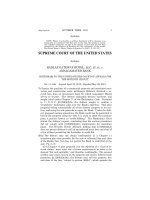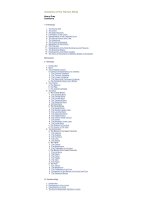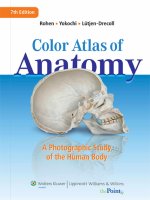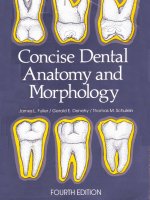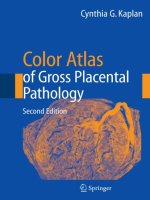color atlas of anatomy - a photog. study of the human body 7th ed. - j. rohen, et al., (lippincott, 2011)
Bạn đang xem bản rút gọn của tài liệu. Xem và tải ngay bản đầy đủ của tài liệu tại đây (41.16 MB, 548 trang )
104750_S_I_XII_Titelei_fertig:_ 05.01.2010 12:37 Uhr Seite XII
This page intentionally left blank.
Color Atlas
of Anatomy
Johannes W.Rohen
Chihiro Yokochi
Elke Lütjen-Drecoll
A Photographic Study
of the Human Body
Seventh Edition
104750_S_I_XII_Titelei_fertig:_ 05.01.2010 12:36 Uhr Seite 1
Coeditions in 20 Languages
104750_S_I_XII_Titelei_fertig:_ 05.01.2010 12:36 Uhr Seite 2
Johannes W.Rohen
Chihiro Yokochi
Elke Lütjen-Drecoll
A Photographic Study
of the Human Body
Seventh Edition
With 1211 Figures,
1117 in Color,
and 94 Radiographs, CT and MRI Scans
Color Atlas
of Anatomy
104750_S_I_XII_Titelei_fertig:_ 22.01.2010 9:02 Uhr Seite 3
IV
Copyright ©
Fourth Edition, 1998
Fifth Edition, 2002
Sixth Edition, 2006
Seventh Edition, 2011 by
Schattauer GmbH,
Hölderlinstraße 3, 70174 Stuttgart, Germany; , and
Lippincott Williams & Wilkins, a Wolters Kluwer business
351 West Camden Street 530 Walnut Street
Baltimore, MD 21201 Philadelphia, PA 19106
All rights reserved. This book is protected by copyright. No part of this book
may be reproduced or transmitted in any form or by any means, including as
photocopies or scanned-in or other electronic copies, or utilized by any
information storage and retrieval system without written permission from
the copyright owner, except for brief quotations embodied in critical articles
and reviews. Materials appearing in this book prepared by individuals as
part of their official duties as U.S. government employees are not covered
by the above-mentioned copyright. To request permission, please contact
Lippincott Williams & Wilkins at 530 Walnut Street, Philadelphia, PA 19106,
via email at , or via website at lww.com (products
and services).
9 8 7 6 5 4 3 2 1
Library of Congress Cataloging-in-Publication data has been applied for
and is available upon request.
DISCLAIMER
Care has been taken to confirm the accuracy of the information present and
to describe generally accepted practices. However, the authors, editors, and
publisher are not responsible for errors or omissions or for any consequences
from application of the information in this book and make no warranty,
expressed or implied, with respect to the currency, completeness, or accuracy
of the contents of the publication. Application of this information in a
particular situation remains the professional responsibility of the practitioner;
the clinical treatments described and recommended may not be considered
absolute and universal recommendations.
The authors, editors, and publisher have exerted every effort to ensure that
drug selection and dosage set forth in this text are in accordance with the
current recommendations and practice at the time of publication. However,
in view of ongoing research, changes in government regulations, and the
constant flow of information relating to drug therapy and drug reactions, the
reader is urged to check the package insert for each drug for any change in
indications and dosage and for added warnings and precautions. This is
particularly important when the recommended agent is a new or infrequently
employed drug.
Some drugs and medical devices presented in this publication have Food and
Drug Administration (FDA) clearance for limited use in restricted research
settings. It is the responsibility of the health care provider to ascertain the
FDA status of each drug or device planned for use in their clinical practice.
To purchase additional copies of this book, call our customer service department
at (800) 638-3030 or fax orders to (301) 223-2320. International customers
should call (301) 223-2300.
Visit Lippincott Williams & Wilkins on the Internet: .
Lippincott Williams & Wilkins customer service representatives are available
from 8:30 am to 6:00 pm, EST.
ISBN: 9781582558561
Prof. Dr. med. Dr. med. h.c. Johannes W.Rohen
Anatomisches Institut II der Universität Erlangen-Nürnberg
Universitätsstraße 19, 91054 Erlangen, Germany
Chihiro Yokochi, M.D.
Professor emeritus, Department of Anatomy
Kanagawa Dental College, Yokosuka, Kanagawa, Japan
Correspondence to:
Prof. Chihiro Yokochi, c/o Igaku-Shoin Ltd., 1-28-23 Hongo,
Bunkyo-ku Tokyo 113-8719, Japan
Prof. Dr. med. Elke Lütjen-Drecoll
Anatomisches Institut II der Universität Erlangen-Nürnberg
Universitätsstraße 19, 91054 Erlangen, Germany
With Collaboration of
Kyung W.Chung, Ph.D.
David Ross Boyd Professor & Vice Chairman
Samuel Roberts Noble Foundation Presidential Professor
Director, Advanced Human Anatomy
University of Oklahoma, College of Medicine
Department of Cell Biology
104750_S_I_XII_Titelei_fertig:_ 05.01.2010 12:36 Uhr Seite IV
V
We would like to express our great gratitude to all coworkers
who helped to make the
Color Atlas of Anatomy
a success. We
are particularly indebted to those who dissected new specimens
with great skill and knowledge, particularly to Jeff Bryant (member
of our staff) and Dr. Martin Rexer (now Klinikum Fürth, Germany),
who prepared most of the new specimens of the fifth, sixth and
seventh edition. We would also like to thank Dr. K. Okamoto
(now Nagasaki, Japan), who dissected many excellent specimens of
the fourth edition, also included in the fifth edition. Furthermore,
we are greatly indebted to Prof. W. Neuhuber and his coworkers
for their great efforts in supporting our work.
The specimens of the previous editions also depicted in this
volume were dissected with great skill and enthusiasm by Prof.
Dr. S. Nagashima (now Nagasaki, Japan), Dr. Mutsuko Takahashi
(now Tokyo, Japan), Dr. Gabriele Lindner-Funk (Erlangen, Germany),
Dr. P. Landgraf (Erlangen, Germany), and Miss Rachel M. McDonnell
(now Dallas, Texas, USA).
We are greatly indebted to Prof. Kyung Won Chung, Ph.D., Director
of Medical Gross Anatomy, University of Oklahoma, USA, Dept.
of Cell Biology, for his careful corrections of the proofs of the
new edition.
Acknowledgements
We would also like to express our many thanks to Prof. W. Bautz
(Radiologisches Institut, University Erlangen-Nürnberg, Germany)
and Prof. A. Heuck (Radiologisches Zentrum, München-Pasing,
Germany), who provided the newly included excellent CT and
MRI scans.
We are also greatly indebted to Mr. Hans Sommer (SOMSO Co.,
Coburg, Germany), who kindly provided a number of excellent
bone specimens.
Finally, we would like to express our great gratitude to our
photographer, Mr. Marco Gößwein, who contributed the very
excellent macrophotos. Excellent and untiring work was done by
our secretaries, Mrs. Lisa Köhler and Elisabeth Wascher, and as
well by our artists, Mr. Jörg Pekarsky and Mrs. Annette Gack, who
not only performed excellent new drawings but revised effectively
the layout of the new edition.
Last but not least, we would like to express our sincere thanks to
all scientists, students, and other coworkers, particularly to the
ones at the publishing companies themselves.
Erlangen, Germany; Spring 2010 J. W. Rohen
C. Yokochi
E. Lütjen-Drecoll
This new edition was revised and structured anew in different
ways. Each chapter is provided with an introductory front page
to give an overview of the topics of the chapter and short
descriptions. The whole introductory chapter “General Anatomy”
was newly arranged and supported with introductory texts, thus
facilitating students to better understand the complicated
“world” of gross anatomy. The large chapter 2 “Head and Neck”
was split into 5 sub-chapters with an introductory page each.
Furthermore, the drawings were revised and improved in many
chapters and depicted more consistently. In most of the chapters
new photographs taken from newly dissected specimens were
incorporated.
The general structure and arrangement of the Atlas were main-
tained. The chapters of regional anatomy are consequently
placed behind the systematic descriptions of the anatomical
structures so that students can study – e.g. before dissecting an
extremity – the systematic anatomy of bones, joints, muscles,
nerves and vessels. For studying the photographs of the specimens
the use of a magnifier might be helpful. The enormous plasticity of
the photos is surprising, especially at higher magnifications.
In many places new MRI and CT scans were added to give consi-
deration to the new imaging techniques which become more
and more important for the student in preclinics. We would like
to express our sincere thanks to Prof. Heuck, Munich, who provided
us with the MRI scans.
In the underlying seventh edition photographs of the surface
anatomy of the human body were included again. We omitted
marks and indications in order not to affect the quality of the
pictures.
Despite numerous additions and amendments the size of the
volume did not increase so that students both in preclinics and in
clinics are offered an atlas easy to handle and cope with.
While preparing this new edition, the authors were reminded of
how precisely, beautifully, and admirably the human body is
constructed. If this book helps the student or medial doctor to
appreciate the overwhelming beauty of the anatomical architecture
of tissues and organs in the human, then it greatly fulfils its task.
Deep interest and admiration of the anatomical structures may
create the “love for man”, which alone can be considered of
primary importance for daily medical work.
We would like to express our great gratitude to all coworkers
for their skilled work. Without their help the improvements of
the
Color Atlas of Anatomy
would not have been possible. We
would also like to express our sincere thanks to those at
Schattauer GmbH, Stuttgart, Germany, Lippincott, Williams &
Wilkins, Baltimore, Maryland, USA, and Igaku-Shoin, Tokyo,
Japan, who always listened to our suggestions and invested
again a great deal of their effort into improving this book.
Preface to the Seventh Edition
104750_S_I_XII_Titelei_fertig:_ 05.01.2010 12:36 Uhr Seite V
VI
Today there exist any number of good anatomic atlases. Conse-
quently, the advent of a new work requires justification. We
found three main reasons to undertake the publication of such a
book.
First of all, most of the previous atlases contain mainly schematic
or semischematic drawings which often reflect reality only in a
limited way; the third dimension, i.e., the spatial effect, is lacking.
In contrast, the photo of the actual anatomic specimen has the
advantage of conveying the reality of the object with its propor-
tions and spatial dimensions in a more exact and realistic manner
than the “idealized”, colored “nice” drawings of most previous
atlases. Furthermore, the photo of the human specimen corre-
sponds to the student’s observations and needs in the dissection
courses. Thus he has the advantage of immediate orientation by
photographic specimens while working with the cadaver.
Secondly, some of the existing atlases are classified by systemic
rather than regional aspects. As a result, the student needs several
books each supplying the necessary facts for a certain region of
the body. The present atlas, however, tries to portray macroscopic
anatomy with regard to the regional and stratigraphic aspects of
the object itself as realistically as possible. Hence it is an imme-
diate help during the dissection courses in the study of medical
and dental anatomy.
Another intention of the authors was to limit the subject to the
essential and to offer it didactically in a way that is self-explana-
tory. To all regions of the body we added schematic drawings
of the main tributaries of nerves and vessels, of the course and
mechanism of the muscles, of the nomenclature of the various
regions, etc. This will enhance the understanding of the details
seen in the photographs. The complicated architecture of the
skull bones, for example, was not presented in a descriptive way,
but rather through a series of figures revealing the mosaic of
bones by adding one bone to another, so that ultimately the
composition of skull bones can be more easily understood.
Finally, the authors also considered the present situation in
medical education. On one hand there is a universal lack of
cadavers in many departments of anatomy, while on the other
hand there has been a considerable increase in the number of
students almost everywhere. As a consequence, students do not
have access to sufficient illustrative material for their anatomic
studies. Of course, photos can never replace the immediate
observation, but we think the use of a macroscopic photo instead
of a painted, mostly idealized picture is more appropriate and is
an improvement in anatomic study over drawings alone.
The majority of the specimens depicted in the atlas were prepared
by the authors either in the Dept. of Anatomy in Erlangen, Germany,
or in the Dept. of Anatomy, Kanagawa Dental College, Yokosuka,
Japan. The specimens of the chapter on the neck and those of
the spinal cord demonstrating the dorsal branches of the spinal
nerves were prepared by Dr. K. Schmidt with great skill and
enthusiasm. The specimens of the ligaments of the vertebral
column were prepared by Dr. Th. Mokrusch, and a great number
of specimens in the chapter of the upper and lower limb was very
carefully prepared by Dr. S. Nagashima, Kurume, Japan.
Once again, our warmest thanks go out to all of our coworkers
for their unselfish, devoted and highly qualified work.
Erlangen, Germany; Spring 1983 J.W. Rohen
C.Yokochi
Preface to the First Edition
104750_S_I_XII_Titelei_fertig:_ 05.01.2010 12:36 Uhr Seite VI
VII
Contents
2 Head and Neck 19
2.1 Skull and Muscles of the Head ______ 19
Bones of the Skull ____________________________ 20
Disarticulated Skull I __________________________ 24
Sphenoidal and Occipital Bones ________________ 24
Temporal Bone ____________________________ 26
Frontal Bone ______________________________ 28
Calvaria ____________________________________ 29
Base of the Skull______________________________ 30
Skull of the Newborn __________________________ 35
Median Sections through the Skull ______________ 36
Disarticulated Skull II __________________________ 38
Ethmoidal Bone ____________________________ 38
Ethmoidal and Palatine Bones__________________ 39
Palatine Bone and Maxilla ____________________ 40
Sphenoidal, Ethmoidal, and Palatine Bones ________ 43
Maxilla, Zygomatic Bone, and Bony Palate ________ 45
Pterygopalatine Fossa and Orbit ________________ 46
Orbit, and Nasal and Lacrimal Bones ____________ 47
Bones of the Nasal Cavity ______________________ 48
Septum and Cartilages of the Nose ______________ 49
Maxilla and Mandible with Teeth ________________ 50
Deciduous and Permanent Teeth ________________ 51
Mandible and Dental Arch ______________________ 52
Ligaments of the Temporomandibular Joint ________ 53
Temporomandibular Joint ____
____________________ 54
Temporomandibular Joint and Masticatory Muscles
__ 55
Masticatory Muscles __________________________ 56
Temporalis and Masseter Muscles ______________ 56
Pterygoid Muscles __________________________ 57
Facial Muscles ________________________________ 58
Supra- and Infrahyoid Muscles __________________ 60
Section through the Cavities of the Head__________ 62
Maxillary Artery ______________________________ 63
2.2 Cranial Nerves________________________ 64
Brain and Cranial Nerves _________________________ 64
Trigeminal Nerve _____________________________ 68
Facial Nerve _________________________________ 70
Connection with the Brain Stem ________________ 71
Nerves of the Orbit __________________________ 72
Base of the Skull with Cranial Nerves ____________ 74
Regions of the Head __________________________ 76
Lateral Region _______________________________ 76
Retromandibular Region ______________________ 80
Para- and Retropharyngeal Regions______________ 83
1 General Anatomy 1
Architectural Principles of the Human Body________ 1
Position of the Inner Organs, Palpaple Points,
and Regional Lines ____________________________ 2
Planes and Directions of the Body
________________ 4
Osteology _____________________________________ 6
Skeleton of the Human Body __________________ 6
Bone Structure _____________________________ 8
Ossification of the Bones
______________________ 9
Arthrology __________________________________ 10
Types of Joints ______________________________ 10
Architecture of the Joint ______________________ 12
Myology ____________________________________ 13
Shapes of Muscles __________________________ 13
Structure of the Muscular System _________________ 14
Comparative Imaging of Skeletal
and Muscular Structures in MRI and X-Ray ________ 15
Organization of the Circulatory System _____________ 16
Organization of the Lymphatic System ____________ 17
Organization of the Nervous System _______________ 18
104750_S_I_XII_Titelei_fertig:_ 14.01.2010 14:45 Uhr Seite VII
VIII
2 Head and Neck
2.3 Brain and Sensory Organs____________ 84
Position of Brain and Great Sensory Organs________ 84
Scalp and Meninges _____________________________ 85
Meninges ______________________________________ 86
Dura Mater and Dural Venous Sinuses ____________ 86
Dura Mater __________________________________ 88
Pia Mater and Arachnoid ________________________ 89
Brain _________________________________________ 90
Median Sections ____________________________ 90
Arteries and Veins __________________________ 92
Arteries __________________________________ 93
Arteries and the Arterial Circle of Willis __________ 98
Cerebrum ________________________________ 99
Cerebellum________________________________ 102
Dissections ________________________________ 104
Limbic System ________________________________ 107
Hypothalamus ___________________________________ 108
Subcortical Nuclei __________________________ 109
Ventricular System __________________________ 112
Brain Stem ________________________________ 114
Coronal and Cross Sections____________________ 116
Horizontal Sections __________________________ 118
Auditory and Vestibular Apparatus ___________________ 122
Temporal Bone __________________________________ 125
Middle Ear ________________________________ 126
Auditory Ossicles _____________________________ 128
Internal Ear _________________________________ 129
Auditory Pathway and Areas ____________________ 131
Visual Apparatus and Orbit _______________________ 132
Eyeball _____ ________________________________ 133
Vessels of the Eye __________________________ 134
Extra-ocular Muscles ________________________ 135
Visual Pathway and Areas ____________________ 137
Layers of the Orbit __________________________ 140
Lacrimal Apparatus and Lids __________________ 142
2.4 Oral and Nasal Cavities ______________ 143
Position of Oral and Nasal Cavities ______________ 143
Nasal Cavity ___________________________________ 144
Paranasal Sinuses __________________________ 144
Nerves and Arteries ___________________________ 146
Sections through the Nasal and Oral Cavities ______ 148
Oral Cavity __________________________________ 150
Muscles __________________________________ 150
Submandibular Triangle ______________________ 152
Salivary Glands ____________________________ 153
2.5 Neck and Organs of the Neck ________ 154
Organization and Regions of the Neck ____________ 154
Muscles of the Neck __________________________ 156
Larynx ______________________________________ 158
Cartilages and Hyoid Bone ____________________ 158
Muscles __________________________________ 160
Vocal Ligament ____________________________ 161
Nerves _____________________________________ 162
Larynx and Oral Cavity _____________________________ 163
Pharynx ____________________________________ 164
Muscles __________________________________ 166
Vessels of the Head and Neck ________________________ 168
Arteries __________________________________ 168
Arteries and Veins __________________________ 170
Veins ____________________________________ 171
Lymph Vessels and Nodes ____________________ 172
Regions of the Neck __________________________ 174
Anterior Region ____________________________ 174
Lateral Region _______________________________ 178
Cervical and Brachial Plexuses __________________ 186
Contents
104750_S_I_XII_Titelei_fertig:_ 14.01.2010 14:45 Uhr Seite VIII
IXContents
3 Trunk 187
Segmental Structure of the Trunk ________________ 187
Skeleton ____________________________________ 188
Vertebrae _____________________________________ 190
Vertebral Column and Thorax _____________________ 192
Vertebral Joints ____________________________ 195
Costovertebral Joints and Intercostal Muscles ______ 196
Costovertebral Joints ________________________ 197
Ligaments ________________________________ 198
Joints Connecting to the Head ____________________ 200
Vertebral Column of the Neck __________________ 203
Surface Anatomy of the Anterior Body ____________ 204
Female __________________________________ 204
Male ____________________________________ 205
Thoracic Wall ________________________________ 206
Thoracic and Abdominal Walls __________________ 209
Vessels and Nerves __________________________ 214
Inguinal Region ______________________________ 217
Male ____________________________________ 217
Female __________________________________ 220
Back __________________________________________ 221
Muscles __________________________________ 221
Nerves __________________________________ 226
Vertebral Canal and Spinal Cord ________________ 230
Nuchal Region __________________________________ 234
4 Thoracic Organs 243
Position of the Thoracic Organs ___________________ 243
Respiratory System _____________________________ 246
Bronchial Tree ________________________________ 246
Projections of Lungs and Pleura ________________ 248
Lungs ____________________________________ 249
Bronchopulmonary Segments __________________ 250
Heart _________________________________________ 252
Myocardium ___________________________________ 257
Valves _____________________________________ 258
Function ____________________________________ 260
Conducting System __________________________ 261
Arteries and Veins __________________________ 262
Regional Anatomy of the Thoracic Organs ___________ 264
Thymus __________________________________ 266
Heart ____________________________________ 268
Pericardium _________________________________ 272
Epicardium ________________________________ 273
Posterior Mediastinum ________________________ 274
Mediastinal Organs ___________________________ 274
Posterior and Superior Mediastinum _______________ 281
Mediastinal Organs ___________________________ 281
Diaphragm __________________________________ 282
Coronal Sections through the Thorax ____________ 284
Horizontal Sections through the Thorax __________ 286
Fetal Circulatory System _________________________ 288
Mammary Gland ________________________________ 290
104750_S_I_XII_Titelei_fertig:_ 05.01.2010 12:36 Uhr Seite IX
X
Contents
6
Retroperitoneal Organs
323
Position of the Urinary Organs __________________ 323
Sections through the Retroperitoneal Region ______ 325
Kidney ______________________________________ 326
Arteries __________________________________ 328
Arteries and Veins __________________________ 329
Retroperitoneal Region ________________________ 330
Urinary System _____ __________________________ 330
Lymph Vessels and Nodes _______________________ 332
Vessels and Nerves _____________________________ 333
Autonomic Nervous System____________________ 334
Male Urogenital System________________________ 336
Male Genital Organs (isolated) __________________ 337
Male External Genital Organs _____________________ 340
Penis ____________________________________ 342
Male Internal Genital Organs _____________________ 343
Testis and Epididymis ________________________ 343
Accessory Glands _______________________________ 344
Pelvic Cavity in the Male ___________________________ 345
Coronal Sections _____________________________ 345
Vessels of the Pelvic Organs _____________________ 346
Abdominal Aorta _____________________________ 348
Vessels and Nerves of the Pelvic Organs __________ 349
Urogenital and Pelvic Diaphragms in the Male _______ 350
Female Urogenital System ______________________ 354
Female Genital Organs (isolated) ________________ 356
Female Internal Genital Organs__________________ 358
Uterus and Related Organs ____________________ 359
Arteries and Lymph Vessels ____________________ 360
Female External Genital Organs ________________ 361
Urogenital Diaphragm
and External Genital Organs in the Female ________ 363
Pelvic Cavity in the Female _______________________ 366
Coronal and Horizontal Sections ________________ 367
5 Abdominal Organs 291
Position of the Abdominal Organs _________________ 291
Anterior Abdominal Wall _________________________ 293
Stomach ____________________________________ 294
Pancreas and Bile Ducts ________________________ 296
Liver _________________________________________ 298
Spleen ______________________________________ 300
Upper Abdominal Organs ______________________ 301
Vessels of the Abdominal Organs ________________ 302
Superior Mesenteric Vessels _____________________ 302
Portal Circulation _____________________________ 303
Superior Mesenteric Artery ____________________ 304
Inferior Mesenteric Artery ____________________ 305
Dissection of the Abdominal Organs _______________ 306
Mesenteric Arteries ___________________________ 308
Mesentery ________________________________ 310
Upper Abdominal Organs _______________________ 311
Posterior Abdominal Wall ______________________ 316
Pancreas and Bile Ducts ______________________ 316
Duodenum, Pancreas, and Spleen _________________ 317
Root of the Mesentery and Peritoneal Recesses ____ 318
Horizontal Sections through the Abdominal Cavity
__ 320
Midsagittal Sections through the Abdominal Cavity
__ 322
104750_S_I_XII_Titelei_fertig:_ 05.01.2010 12:36 Uhr Seite X
XI
7 Upper Limb 368
Skeleton of the Shoulder Girdle and Thorax _________ 368
Scapula _______________________________________ 371
Skeleton of the Shoulder Girdle and Humerus
______ 372
Humerus ____________________________________ 373
Skeleton of the Forearm _________________________ 374
Skeleton of the Forearm and Hand __________________ 375
Skeleton of the Hand __________________________ 376
Joints and Ligaments of the Shoulder ____________ 378
Ligaments of the Elbow Joint _____________________ 379
Ligaments of the Hand and Wrist ________________ 380
Muscles of the Shoulder and Arm ________________ 382
Dorsal Muscles _________________________________ 382
Pectoral Muscles _____________________________ 384
Muscles of the Arm _____________________________ 386
Muscles of the Forearm and Hand _________________ 388
Flexor Muscles ____________________________ 388
Extensor Muscles __________________________ 392
Muscles of the Hand __________________________ 394
Arteries _________________________________________ 396
Veins ____________________________________________ 398
Nerves _______________________________________ 399
Surface Anatomy of the Upper Limb ______________ 401
Posterior and Lateral Aspects __________________ 401
Anterior Aspect ____________________________ 402
Neck and Shoulder ____________________________ 403
Shoulder ____________________________________ 404
Posterior Region _____________________________ 404
Anterior Region ____________________________ 406
Shoulder and Arm ____________________________ 408
Axillary Region ___________________________________ 410
Brachial Plexus ___________________________________ 413
Arm ________________________________________ 414
Cubital Region _________________________________ 416
Forearm and Hand ____________________________ 420
Posterior Region ____________________________ 420
Anterior Region ____________________________ 422
Hand _________________________________________ 424
Posterior Region ____________________________ 424
Anterior Region ____________________________ 426
Sections through the Upper Limb ________________ 430
8 Lower Limb 432
Skeleton of the Pelvic Girdle and Lower Limb ______ 432
Bones of the Pelvis ____________________________ 433
Skeleton of the Pelvis ___________________________ 435
Bones of the Hip Joint ___________________________ 438
Femur ______________________________________ 439
Skeleton of the Leg _____________________________ 440
Bones of the Knee Joint ________________________ 441
Skeleton of the Foot __________________________ 442
Ligaments of the Pelvis and Hip Joint ____________ 444
Knee Joint _______________________________________ 446
Ligaments of the Knee Joint ____________________ 447
Joints of the Ankle ____________________________ 449
Ligaments of the Foot ___________________________ 450
Muscles of the Thigh __________________________ 452
Adductor Muscles __________________________ 452
Gluteal Muscles ____________________________ 454
Flexor Muscles _______________________________ 455
Muscles of the Leg ____________________________ 457
Flexor Muscles _______________________________ 457
Muscles of the Leg and Foot ____________________ 458
Deep Flexor Muscles ________________________ 460
Extensor Muscles _____________________________ 462
Muscles of the Foot _____________________________ 463
Arteries _______________________________________ 466
Veins _________________________________________ 468
Nerves ______________________________________ 470
Lumbosacral Plexus ___________________________ 471
Lumbar Part of the Vertebral Canal and Spinal Cord
__ 472
Spinal Cord with Intercostal Nerves ______________ 474
Spinal Cord and Lumbar Plexus __________________ 475
Surface Anatomy of the Lower Limb ______________ 476
Posterior Aspect ____________________________ 476
Anterior Aspect ____________________________ 477
Thigh ______________________________________ 478
Anterior Region ____________________________ 478
Gluteal Region _________________________________ 482
Thigh ______________________________________ 484
Posterior Region ____________________________ 484
Knee and Popliteal Fossa ______________________ 486
Crural Region ________________________________ 489
Crural Region and Foot ________________________ 492
Coronal Sections through the Foot ______________ 495
Sections through the Lower Limb ________________ 496
Foot ________________________________________ 498
Posterior Region ____________________________ 498
Anterior Region ____________________________ 500
Contents
Index
_____________________________________
503
104750_S_I_XII_Titelei_fertig:_ 14.01.2010 14:46 Uhr Seite XI
XII
104750_S_I_XII_Titelei_fertig:_ 05.01.2010 12:37 Uhr Seite XII
This page intentionally left blank.
1
1 General Anatomy
Three general principles are recognizable in the architecture of the human
organism:
1. The principle of polarity: Polarity is reflected mainly in the formal and
functional contrast between the head (predominantly spherical form) and
the extremities (radially arranged skeletal elements). In the phylogenetic
development of the upright position of the human body, polarity developed
also among the extremities: The lower extremities provide the basis for
locomotion whereas the upper extremities are not needed anymore for
locomotion, so they can be used for gesture, manual and artistic activities.
2. The principle of segmentation: This principle dominates in the trunk. The
anatomical structures (vertebrae, pairs of ribs, muscles, and nerves) are arranged
segmentally and replicate rhythmically in a similar way.
3. The principle of bilateral symmetry: Both sides of the body are separated
by a midsagittal plane and resemble each other like image and mirror-image.
There are also different principles in
the architecture and function of the
inner organs:
The skull contains the brain and the
sensory organs. They are arranged
like mirror and mirror-image and are
the basis of our consciousness.
The thorax contains the organs of
the rhythmic system (heart, lung),
which are only to some extent
bilaterally organized. The conscious-
ness (feeling, etc.) is located in-
between.
In the abdominal cavity, the most
important abdominal
organs (intesti-
nal tract, liver, pancreas)
are arranged
unpaired. Their functions remain
subconscious.
Coronal section through the thoracic and
abdominal cavity.
Horizontal section through the head at the
level of the eyes.
104750_S_001_018_Kap_1:_ 04.01.2010 12:55 Uhr Seite 1
1
2
13
14
15
16
17
18
C
C
D
D
B
B
AA
3
5
7
8
4
6
9
2 Position of the lnner Organs, Palpable Points, and Regional Lines
The bones of the skeletal system are palpable through the
skin at different points. This enables physicians to localize
the inner organs. On the ventral side, the clavicle,
sternum, ribs, and intercostal spaces are palpable. Further-
more, the anterior iliac spine and the symphysis can be
localized. For better orientation, several lines of orienta-
tion are used, e.g., the parasternal line, the midclavicular
line, the anterior axillary line, the umbilical-pelvic line.
By means of these lines, the heart and the position of the
vermiform process can be localized.
Regional lines and palpable points at the ventral side of the
human body.
Regional lines
A = parasternal line
B = midclavicular line
C = anterior axillary line
D = umbilical-pelvic line
Position of the inner organs of the human body
(anterior aspect).
The main cavities of the body and their
contents.
104750_S_001_018_Kap_1:_ 04.01.2010 12:55 Uhr Seite 2
3
19
20
21
22
3
8
10
7
11
12
G
G
H
H
F
F
EE
Position of the lnner Organs, Palpable Points, and Regional Lines
At the dorsal side of the body, the posterior spines of the
vertebral column, the ribs, the scapula, the sacrum, and
the iliac crest are palpable. Lines of orientation are the
paravertebral line, the scapular line, the posterior axillary
line, and the iliac crest.
Position of the inner organs of the human body
(posterior aspect).
1 Brain
2 Lung
3 Diaphragm
4 Heart
5 Liver
6 Stomach
7 Colon
8 Small intestine
9 Testis
10 Kidney
11 Ureter
12 Anal canal
13 Clavicle
14 Manubrium sterni
15 Costal arch
16 Umbilicus
17 Anterior superior iliac spine
18 Inguinal ligament
19 Scapular spine
20 Spinous processes
21 Iliac crest
22 Coccyx and sacrum
Regional lines and palpable points at the dorsal side of the
human body.
Regional lines
E = paravertebral line
F = scapular line
G = posterior axillary line
H = iliac crest
104750_S_001_018_Kap_1:_ 04.01.2010 12:55 Uhr Seite 3
4
Sagittal section through the knee joint.
Horizontal section through the pelvic cavity and the hip
joints.
MRI scan through the pelvic cavity and the hip joints (horizon-
tal or axial or transverse plane).
A
B
4
2
3
1
Planes and Directions of the Body
MRI scan through the knee joint (sagittal plane).
Planes of the body:
A = horizontal or axial or transverse plane
B = sagittal plane (at the level of the knee joint)
Directions:
1 = cranial 3 = anterior (ventral)
2 = caudal 4 = posterior (dorsal)
104750_S_001_018_Kap_1:_ 04.01.2010 12:55 Uhr Seite 4
5
Median section through the trunk of a female.
A
B
3
4
6
5
2
1
Planes and Directions of the Body
MRI scan through the pelvic cavity and the hip joints (frontal or coronal
plane).
Planes of the body:
A = midsagittal or median plane
B = frontal or coronal plane (through the pelvic cavity)
Directions:
1 = posterior (dorsal) 4 = medial
2 = anterior (ventral) 5 = cranial
3 = lateral 6 = caudal
104750_S_001_018_Kap_1:_ 04.01.2010 12:55 Uhr Seite 5
6
1
4
7
6
8
19
15
16
18
14
22
23
24
25
26
17
5
12
13
28
30
31
34
32
33
35
36
37
8
10
16
11
27
12
30
31
38
3
2
9
20
21
23
22
13
29
31
33
32
Osteology: Skeleton of the Human Body
Skeleton of a female adult (anterior aspect). Skeleton of a female adult (posterior aspect).
104750_S_001_018_Kap_1:_ 04.01.2010 12:55 Uhr Seite 6
7
1
4
6
8
9
15
17
21
11
22
23
24
25
26
31
34
32
33
35
36
37
Osteology: Skeleton of the Human Body
Axial skeleton
Head
1 Frontal bone
2 Occipital bone
3 Parietal bone
4 Orbit
5 Nasal cavity
6 Maxilla
7 Zygomatic bone
8 Mandible
Trunk and thorax
Vertebral column
9 Cervical vertebrae
10 Thoracic vertebrae
11 Lumbar vertebrae
12 Sacrum
13 Coccyx
14 Intervertebral discs
Thorax
15 Sternum
16 Ribs
17 Costal cartilage
18 Infrasternal angle
Appendicular skeleton
Upper limb and shoulder girdle
19 Clavicle
20 Scapula
21 Humerus
22 Radius
23 Ulna
24 Carpal bones
25 Metacarpal bones
26 Phalanges of the hand
Lower limb and pelvis
27 Ilium
28 Pubis
29 Ischium
30 Symphysis pubis
31 Femur
32 Tibia
33 Fibula
34 Patella
35 Tarsal bones
36 Metatarsal bones
37 Phalanges of the foot
38 Calcaneus
Skeleton of a 5-year-old child (anterior aspect).
The zones of the cartilaginous growth plates are seen (arrows).
In contrast to the adult, the ribs show a predominantly
horizontal position.
104750_S_001_018_Kap_1:_ 04.01.2010 12:55 Uhr Seite 7
8 Osteology: Bone Structure
Femur of the adult. Coronal section of the
proximal and distal epiphyses displaying the
spongy bone and the medullary cavity.
1
3
1
2
3
4
2
5
1
3
Coronal section through the proximal end
of the adult femur showing the characteristic
structure of the spongy bone.
Three-dimensional representation on the
trajectorial lines of the femoral head
(according to B. Kummer).
1
2
4
1
2
4
MRI scan of the right femur and the hip
joint (coronal section) (from Heuck et al.,
MRT-Atlas, 2009).
X-ray of the right femur and the hip joint
(a p. direction).
1 Head of the femur
2 Spongy bone
3 Diaphysis of the femur
4 Compact bone
5 Articular cartilage
▲▲
104750_S_001_018_Kap_1:_ 04.01.2010 12:55 Uhr Seite 8
9
5
6
7
8
4
2
3
▲
▲
▲
Osteology: Ossification of the Bones
1 Ossification center in the
head of the femur
2 Greater trochanter
3 Head of the femur
4 Neck of the femur
The ossification of the bones of the limbs starts within
the ossification centers of the primary cartilagenous
bones. Here, the medullary cavity develops. The ossifica-
tion process of limb bones is not finished at birth.
5 Lateral condyle
6 Medial condyle
7 Intercondylar notch
8 Diaphysis
Ossification of the femur (left: coronal section,
right: posterior view of the femur). Arrows: distal epiphysis.
1 Scapula 6 Radius
2 Shoulder joint 7 Tibia
3 Humerus 8 Fibula
4 Elbow joint 9 Knee joint
5 Ulna 10 Femur
1 Ulna 6 Fibula
2 Radius 7 Talus
3 Metacarpals 8 Calcaneus
4 Phalanges 9 Metatarsals
5 Tibia 10 Phalanges
X-ray of hand and foot of a newborn.
X-ray of the upper and lower limb of a newborn child
(left: upper limb, right: lower limb). Arrows: ossification centers.
104750_S_001_018_Kap_1:_ 04.01.2010 12:55 Uhr Seite 9
10 Arthrology: Types of Joints
2
4
1
1
3
3
1
2
Shoulder joint as an example of a multiaxial ball-
and-socket joint (coronal section).
Elbow joint with ligaments as an
example of a hinge joint (monaxial
humero-ulnar joint) in combination
with a pivot joint (monaxial radio-ulnar
joint), which allows rotation.
Coronal section of the elbow joint
(MRI scan, courtesy of Prof. Heuck, Munich).
The possibilities of movement are shown in the
schematic drawings on p. 11.
Ball-and-socket joint with its
different axes (schematic drawing).
Arrows: axes of movement.
1 Humerus
2 Radius
3 Ulna
4 Articular cavity (shoulder joint)
5 Metacarpophalangeal joint
6 Joints of fingers
Skeleton of the right arm
and shoulder girdle
(anterior aspect).
1
2
3
104750_S_001_018_Kap_1:_ 04.01.2010 12:55 Uhr Seite 10
11Arthrology: Types of Joints
4
1
2
3
5
6
6
Skeleton of right wrist and hand (medial aspect).
The metacarpophalangeal joints are biaxial, as is
the carpometacarpal joint of the thumb (✽ in the
figure). The joints of the fingers, however, are
monaxial.
Joints exhibit a variety of functions. In
general, mobility becomes reduced in the
direction from proximal to distal. The hip
joint, e.g., is multiaxial; the knee joint is
biaxial, and the joints of toes and fingers are
monaxial.
Pivot joint
(e.g. radio-ulnar joint).
Hinge joint
(e.g. humero-ulnar joint). Left: extension, right: flexion.
Arrows: axes of movement.
Saddle joint
(e.g. carpometacarpal joint of
the thumb).
Coronal section of the shoulder joint
(MRI scan, from Heuck et al., MRT-Atlas, 2009).
✽
104750_S_001_018_Kap_1:_ 04.01.2010 12:55 Uhr Seite 11


